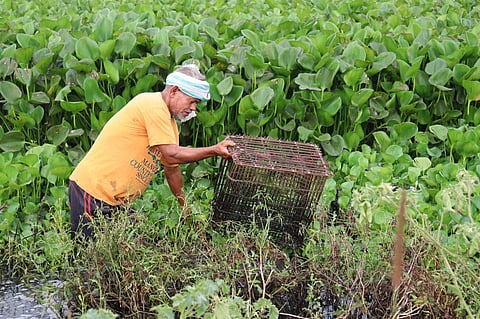

You have to look at Deepor Beel, a freshwater lake to the Southwest of Guwahati, Kamrup district of Assam, to really understand how beautiful it is. It is best known for the migratory birds it hosts plus the vegetation and aquatic life it supports. A Ramsar site and located within the bounds of Deepor Beel Bird Sanctuary, it is because of the latter, being a protected reserve area, that nine fishing communities dependent on the lake had only restricted or no access to it. But in a roundabout way, six smart women are slowly reviving that relationship. You see, the growing menace on the lake’s surface that is water hyacinth is proving to be quite difficult to deal with. And now, this invasive species is being used to make yoga mats and at the helm of the project are youngsters who named the initiative Simang, which is the Assamese word for dream.
Mitali Das, Mainu Das, Bhantia Das, Situa Das, Rumi Das and Mamoni Das were already introduced to Rachel MacHenry, Director of Design, 7Weaves Social. This Canadian designer was working with the communities of Loharghat Reserve Forest on sustainable and traditional textiles. COVID was still no insight as it was 2019 and it is in this year when the girls and the designer discovered the potential that water hyacinth holds and a way to make contemporary products made from it. "The idea started with converting water hyacinth into fibre and turning it into a product. The idea was further developed when a team of Swiss designers visited for 15 days and trained the girls. They even took back the products created to their own country to see if it can find a market there," explains Rituraj Dewan from North East Centre for Technology Application and Reach (NECTAR) who has been involved with the project. He also introduces us to a very shy Mitali who gives us more information.
But when COVID came calling, the six women decided to train all the nine communities in this tedious art. The first step was the collection of meteka, which is what water hyacinth is called in Assamese, from the lake. Each mat requires 2 kg of this aquatic plant which is achieved after drying 12 kgs of it. Needless to say, all of it is collected from Deepor Beel and every step of the way, the nine traditional communities are involved. It takes about 15 days for the plant to dry completely. "Initially, all women used to come together to cut the plant in a certain way that's suitable for weaving and dry it out completely. But since COVID, we deliver the dried up plants and they do it at their home," explains Rituraj.
The fibre is then weaved using traditional Assamese loom, something the community is already acquainted with and they are required to work for eight hours 20 days a week to earn Rs 6,000, which is the minimum any weaver earns anyway. And this is how the Moorhen yoga mat, which takes its name from Kam Sorai (purple moorhen, a resident bird of Deepor Beel Wildlife sanctuary), is made. The plan was to launch on International Yoga Day but due to the lockdown, they couldn't complete their orders. But the MoU they signed with NECTAR in March 2021, who have also supplied them with looms, will anyway help them find a market for their product.
Talking a little more about the mat, it is Sneha Chaudhary, Textile Designer, 7Weaves, who helped design it and proposed that a natural fibre like cotton be used with the water hyacinth fibre. Many different permutations and combinations were tried to ensure the ones that give the best strength and grip, along with being flexible and soft, are chosen. What's more? The 100% biodegradable and 100% compostable mat itself comes in a cotton canvas bag with no zip or metal enclosures, but adjustable straps instead. Over 44 fishing communities are engaged with the production process which is ensuring that their bond with the wetlands remains strong.
